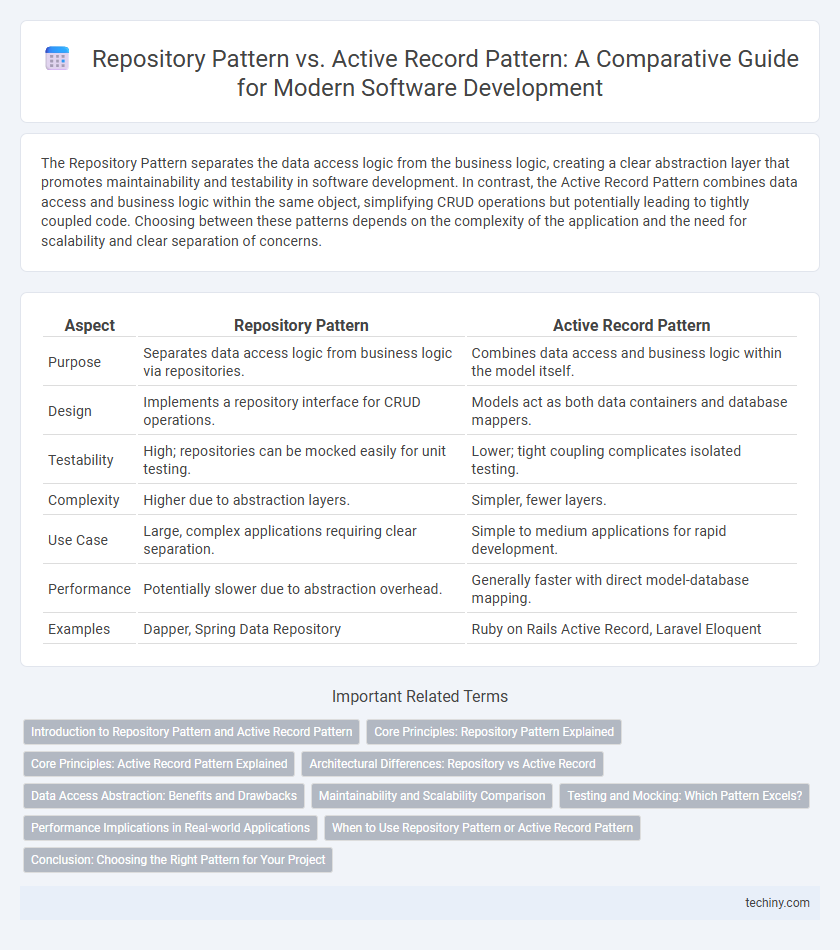The Repository Pattern separates the data access logic from the business logic, creating a clear abstraction layer that promotes maintainability and testability in software development. In contrast, the Active Record Pattern combines data access and business logic within the same object, simplifying CRUD operations but potentially leading to tightly coupled code. Choosing between these patterns depends on the complexity of the application and the need for scalability and clear separation of concerns.
Table of Comparison
| Aspect | Repository Pattern | Active Record Pattern |
|---|---|---|
| Purpose | Separates data access logic from business logic via repositories. | Combines data access and business logic within the model itself. |
| Design | Implements a repository interface for CRUD operations. | Models act as both data containers and database mappers. |
| Testability | High; repositories can be mocked easily for unit testing. | Lower; tight coupling complicates isolated testing. |
| Complexity | Higher due to abstraction layers. | Simpler, fewer layers. |
| Use Case | Large, complex applications requiring clear separation. | Simple to medium applications for rapid development. |
| Performance | Potentially slower due to abstraction overhead. | Generally faster with direct model-database mapping. |
| Examples | Dapper, Spring Data Repository | Ruby on Rails Active Record, Laravel Eloquent |
Introduction to Repository Pattern and Active Record Pattern
The Repository Pattern abstracts data access layers by encapsulating logic for retrieving and mapping data between domain and data sources, promoting separation of concerns and maintainability in software development. The Active Record Pattern combines data access and business logic within the same object, simplifying CRUD operations but potentially leading to tight coupling between database schemas and domain models. Understanding these patterns aids developers in choosing the appropriate architecture for scalable, testable, and clean codebases.
Core Principles: Repository Pattern Explained
The Repository Pattern centralizes data access logic by abstracting database interactions into a dedicated repository interface, promoting separation of concerns and easier unit testing. It encapsulates query operations and data mapping, providing a consistent API to the domain layer regardless of the underlying data source. This pattern enhances maintainability by decoupling business logic from direct database manipulation commonly seen in the Active Record Pattern.
Core Principles: Active Record Pattern Explained
The Active Record pattern tightly couples an object's data with its database operations, encapsulating CRUD functionality within the domain model itself. This design simplifies development by treating each entity as both a data container and an active component responsible for persistence logic. Core principles emphasize direct mapping between the object and its corresponding database table, promoting ease of use but potentially increasing coupling and reducing separation of concerns.
Architectural Differences: Repository vs Active Record
The Repository pattern separates the domain and data mapping layers, centralizing data access logic within repository classes to enforce a clear separation of concerns. Active Record pattern couples domain objects with database access, where each object directly manages its persistence, blending business logic with data manipulation. Architecturally, Repository promotes testability and scalability by abstracting data sources, while Active Record favors simplicity and rapid development by integrating database operations within the domain model.
Data Access Abstraction: Benefits and Drawbacks
The Repository Pattern abstracts data access by encapsulating database operations within a separate layer, promoting testability and decoupling business logic from persistence mechanisms. In contrast, the Active Record Pattern combines data access and domain logic within the same object, simplifying implementation but risking tight coupling and reduced flexibility. Choosing between these patterns impacts maintainability, with Repository Pattern offering better scalability in complex applications while Active Record suits simpler, CRUD-heavy scenarios.
Maintainability and Scalability Comparison
The Repository Pattern enhances maintainability by decoupling business logic from data access, allowing easier modifications and testing without affecting the domain model. In terms of scalability, it supports complex query optimizations and can integrate multiple data sources, promoting robust and flexible application growth. The Active Record Pattern, while simpler to implement, often couples data and behavior tightly, which can hinder maintainability in large projects and limit scalability due to its less modular structure.
Testing and Mocking: Which Pattern Excels?
The Repository Pattern excels in testing and mocking by abstracting data access behind interfaces, enabling easy substitution with mock repositories for unit testing without database dependencies. In contrast, the Active Record Pattern tightly couples domain logic with persistence, making isolation of business logic from database calls challenging during tests. Consequently, developers often prefer the Repository Pattern for its clearer separation of concerns and enhanced testability in software development.
Performance Implications in Real-world Applications
The Repository Pattern enhances performance in real-world applications by abstracting data access layers, enabling optimized queries and batch operations that reduce database roundtrips. In contrast, the Active Record Pattern, while simpler to implement, can lead to inefficient performance due to tight coupling of business logic and data access, often causing excessive database calls and slower response times. Choosing the Repository Pattern allows better scalability and maintainability, crucial for large-scale software systems where performance optimization is critical.
When to Use Repository Pattern or Active Record Pattern
Use the Repository Pattern when managing complex domain logic and maintaining a separation between business rules and data access to promote testability and scalability. Choose the Active Record Pattern for simpler applications with straightforward CRUD operations where coupling data with behavior reduces boilerplate code. In scenarios requiring flexibility across multiple data sources or complex querying, the Repository Pattern provides a more robust and maintainable solution.
Conclusion: Choosing the Right Pattern for Your Project
Selecting the appropriate design pattern between Repository and Active Record depends on the complexity and scalability requirements of the software project. Repository Pattern offers better separation of concerns and is ideal for large-scale applications requiring complex domain logic and testability, while Active Record simplifies CRUD operations and suits smaller projects with straightforward data interactions. Evaluating factors like maintainability, domain complexity, and team expertise ensures the right architectural choice for efficient software development.
Repository Pattern vs Active Record Pattern Infographic

 techiny.com
techiny.com